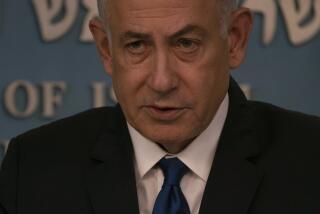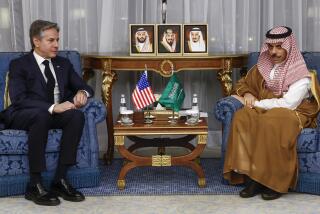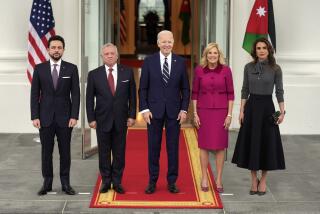Reagan Orders Shultz Back to Mideast
- Share via
BRUSSELS — President Reagan on Wednesday ordered Secretary of State George P. Shultz to resume his Middle East peace mission, but a White House official said it would be a mistake to “go overboard” about the chances for success.
“It is clear all countries in the region believe it is useful for the United States to remain engaged in this process,” Reagan said during a break from the North Atlantic Treaty Organization summit conference. “We’ll spare no effort in our search for a comprehensive peace settlement.”
Shultz plans to go first to London, leaving soon after the NATO meeting ends about midday today. There he will confer with King Hussein of Jordan, who has been in London for more than a week undergoing what the palace in Amman described as “elective” dental work.
On Friday, Shultz is scheduled to visit Jerusalem, Damascus and Cairo before returning to Washington.
Little Shuttle Progress
So far, Shultz has little to show for his exhausting shuttle, which began last Wednesday. Hussein, Israeli Prime Minister Yitzhak Shamir and Syrian President Hafez Assad have all expressed strong reservations about parts of the Shultz plan.
Only Egypt, which withdrew from active participation in the Arab-Israeli conflict in 1979, when it became the first Arab nation to sign a peace treaty with Israel, has offered even a qualified endorsement of the American initiative.
Shultz displayed a few signs of frustration Wednesday, telling a television interviewer that the festering issue of Palestinian representation at a peace conference is “only one impossible problem; the place is full of impossible problems.”
Earlier, the usually tightly controlled Shultz temper flared when a reporter, in a shouted question, asked why he was returning to the Middle East when he had accomplished so little in his last swing through the area. Shultz replied, “Up yours, too.”
Cautious Optimism
White House spokesman Marlin Fitzwater said there are some reasons to be optimistic about the Shultz initiative but added, “You don’t want to go overboard.”
Shultz has made it clear that he does not expect instant success. Instead, his objective is to wear away objections bit by bit, eventually convincing all parties that the U.S. plan is the only one that offers any hope of a settlement.
“You could describe my effort as trying to find a blend of substance and procedure that will help people get going,” Shultz said in an interview with Cable News Network.
“People are reluctant to start on a procedure of negotiations until they have some sense of where they are going,” he added, spelling out a kind of Catch-22 in the process: All the parties insist on knowing the outcome of the talks before they start talking.
Trying to Close Gap
Shultz’s technique in meeting each of the key leaders has been to outline the U.S. plan and then describe the others’ reaction to it. The idea is to try to gradually close the gap between the various positions, although apparently he has not done so yet.
The apparent reason for resuming the shuttle is to allow Shultz to carry one more round of messages between the parties before returning to Washington. Prime Minister Shamir is scheduled to visit the United States starting March 14, and Shultz probably will return to the Middle East sometime after that.
It is not clear just what Shultz and Hussein will have to talk about today. Hussein was the last leader he saw before breaking away for the NATO meeting, and Shultz is not likely to have any new word from any other party to report to the monarch.
U.S. officials said that at the earlier meeting, Hussein neither accepted nor rejected the U.S. approach, but the Jordanian royal court issued a statement later saying the plan requires important changes.
More to Read
Sign up for Essential California
The most important California stories and recommendations in your inbox every morning.
You may occasionally receive promotional content from the Los Angeles Times.













